Lowrance Elite 5/7 cheap CHIRP, the sonar wars rage on
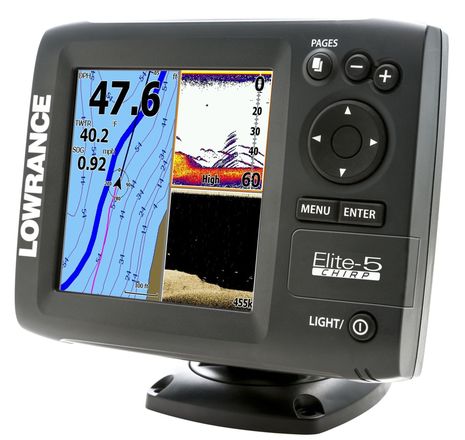 Lowrance just launched Elite-5 and -7 CHIRP fishfinders and plotter combos today, but they showed off working prototypes during the Navico writer’s event I attended in January. What seemed to particularly excite the product managers was the Elite’s new ability “to produce low, medium and high CHIRP sonar ranges and display two user-selected ranges simultaneously” using just an “affordable” HDI Skimmer transducer. Apparently they didn’t realize that this tranducer could usefully CHIRP until they tried it, and now they think they have a edge in the sonar battle that’s taking place both on the water and in law offices…
Lowrance just launched Elite-5 and -7 CHIRP fishfinders and plotter combos today, but they showed off working prototypes during the Navico writer’s event I attended in January. What seemed to particularly excite the product managers was the Elite’s new ability “to produce low, medium and high CHIRP sonar ranges and display two user-selected ranges simultaneously” using just an “affordable” HDI Skimmer transducer. Apparently they didn’t realize that this tranducer could usefully CHIRP until they tried it, and now they think they have a edge in the sonar battle that’s taking place both on the water and in law offices…
In December I hailed the Elite-4 HDI as a lot of fishfinder and plotter technology at a low cost, but of course a 7-inch screen can reveal a lot more information, especially when you can put a long scroll of CHIRP sonar right above the same track imaged with high-frequency DownScan. The Elite-7x CHIRP fishfinder — which will retail for $649 in April, with a 4-frequency transducer — also includes NMEA 2000, as will the Elite-7 fishfinder/plotter at $849 with quite a bundle of Navionics salt and freshwater cartography.
Raymarine was arguably the first to offer cheap CHIRP sonar when they introduced the 5.7-inch Dragonfly early last year, and Lowrance had one installed for comparison. Ray doesn’t offer the same level of CHIRP sonar control but does purportedly apply CHIRP to what it calls DownVision. As noted in my entry about the writer demos, the DragonFly above did not seem as sharp as what I’d seen in Miami a year earlier.
Raymarine is also cleverly running a Dragonfly Screen Capture Competition, and you can find out what’s happening on winning screens like the ones above. Yes, that is a jet plane at lower left, and that’s an underwater statue quite sharply imaged at lower right (and there are more Dragonfly screen captures here.) I can’t find a screenshot library at the Humminbird site anymore but a Google search definitely brings up lots of memorable images from their long history of sonar innovation.
And along comes Garmin! Above are some screenshots from the simulator that came as part of a huge recent GPSMap 741sx software update. So now the 741 and other Garmin displays can show CHIRP-assisted DownVu and SideVu networked from the various new sonar products introduced last November. And note the nice multi-window split control that also came with the update. I think that Bill Bishop is intalling his first Garmin down/side sonar this week and hopefully he’ll soon be sharing the results with Panbo readers.
In short, boaters now have a LOT of CHIRP/down/side sonar choices, even at the low end of marine electronics pricing. And I’m optimistic that the patent disputes going on behind the scenes will not throw a wrench in any company’s developements. No one will talk about the details, even off the record, but here’s what I think is going on. Humminbird’s parent Johnson Outdoors has a side scan sonar imaging patent (perhaps two) that they once used to sue Navico regarding StructureScan. But Navico had a downscan imaging sonar patent (perhaps two) that Humminbird wanted to use and the two companies probably swapped rights, which may have strengthened both their claims. The settlement was not explained, but both now offer both types of scanning. Plus Navico then sued Raymarine over downscanning, which was just somehow settled last week. If my presumptions here are correct, Garmin may soon be sued by both Johnson Outdoors and Navico, though I suspect the parties already have agreements in mind or maybe already in place.
I don’t like seeing money that could be used for more R&D or lower product prices going to patent lawyers — and some claims at least look ridiculous (like Briartek’s) — but reasonable trades and/or fees shouldn’t create major problems. And while Navico’s Leif Ottosson told me that something like 20 million dollars may exit the marine electronics industry this year due to (non sonar) patent litigation, he is asking his fellow chief executives to at least talk to each other before filing suits. It’s fascinating to look at these patents, screenshots, and demos trying to figure out who has the best sonar technology. Lets all hope that every company gets a crack at producing the best views of the structure and wild life in the waters around our boats.


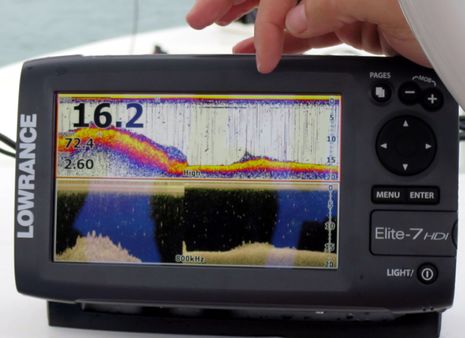
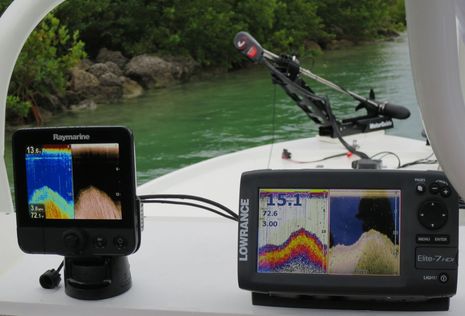
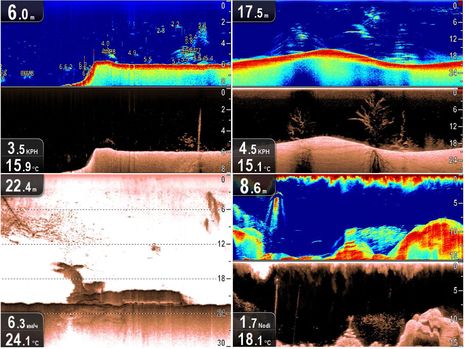
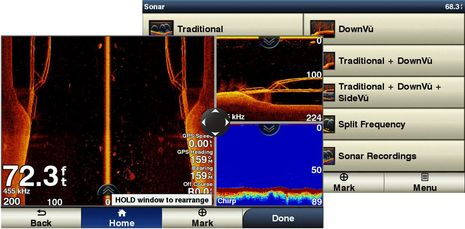
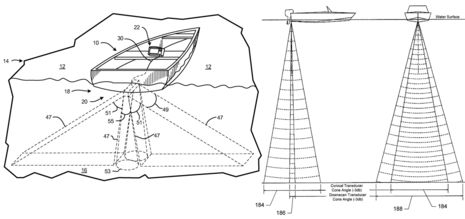
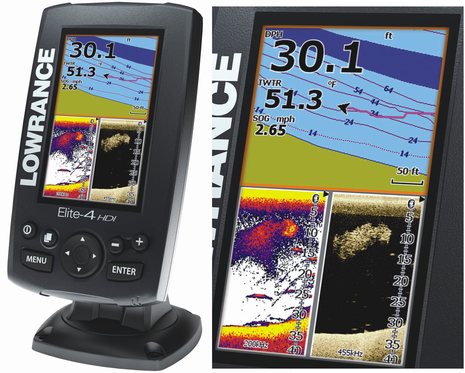
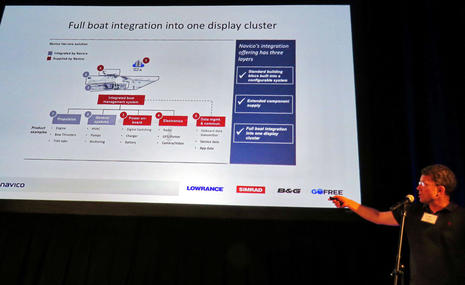










Incidentally, a guy at The Hull Truth put up an deeply technical explanation of how CHIRP works here: http://goo.gl/1aVo9R
And Bill Bishop recently wrestled with the issue of how much area is covered by a CHIRP transducer’s variable transmission cone: http://goo.gl/VjQ0cl
I think that both articles were carefully researched but this stuff is hard!
Hi Ben,
I’m sure you will agree with me that the last decade has been very exciting when it comes to recreational marine electronics, sonar in particular. First was the amazing life like SideImaging by Humminbird, then Lowrance launched the mind blowing 800kHz True DownScan with their LSS-1, and then Garmin with their crystal clear True CHIRP. Unfortunately, along the way their have been some real disasters too, like DownImaging from SideImaging. These disasters are in my opinion created as a ‘quick fix’ to be competitive, and sometimes comes at a long term cost. I hope this is not what we can come to expect from our Big Brand Marine Electronics Houses. I would hate to see the word ‘CHIRP’ get exploited like what happened to ‘DownScan’. We won’t even discuss ‘all-round/forward’ sonar at this point.
Here’s holding thumbs and putting faith in the engineers and marketers to do the right thing.
Regards
John
I was wrong to qualify Raymarine’s DownVision as “purportedly” CHIRP assisted and I just crossed out the word. The Dragonfly really is broadcasting two ranges of frequencies from Ray’s own custom designed CHIRP transducer, though the specification are oddly vague about it: http://goo.gl/yo28ym
However, I think Jim Hebert got the details right on Continuous Wave when the Dragonfly first came out:
“The device employs two ranges of frequencies. A range of 320-kHz to 380-kHz is used, as well as a range from 170-kHz to 230-kHz.” http://goo.gl/2lS0BE
Plus, Ray’s CP100 does list a spec of “Centre frequency DownVision 350 kHz” http://goo.gl/Tia5KY
At any rate, when the inexpensive Dragonfly came out with vague specs and no user control over the frequencies used, some people (especially competitors) questioned if it was using “real” CHIRP.
Today there’s plenty of evidence that Raymarine is using the CHIRP term properly, starting with the impressive user screen captures linked to above. Dragonfly doesn’t offer two DownVision frequencies and yet seems able to capture high frequency detail while also seeing deeper and at higher speed, all of which CHIRP could help with.
Finally, while Dragonfly appeared when all other CHIRP was in big expensive devices, now Lowrance and Garmin also seem able to use CHIRP tech in smaller devices with modest transducers. “Cheap CHIRP” isn’t meant to sound dismissive; it’s a good thing.
Hi, boy its hard to keep it all straight. I have one question. If the Lowrance has nmea 200 can I use it to display radar or auto pilot from a existing unit? i know that this can not be done o n the Raymarine unit and is the reason I have held off buying it.
I took a look at the Raymarine CP-100 (which I could add to my system easily) – when they can do a forward sweep like they do side-to-side, I’m interested! (assuming I don’t need some massive transducer underneath – the CPT-110/120 is OK).
Wow, Lowrance is not messing around with this video comparison of its DownScan imaging versus the ClearVu Garmin offers now that it has had to modify its transducers due to the ongoing patent issue:
https://youtu.be/klwhx0SndJQ